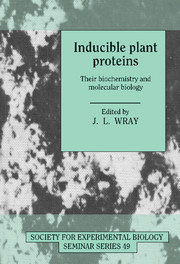Book contents
- Frontmatter
- Contents
- List of Contributors
- Preface
- Metal-binding proteins and metal-regulated gene expression in higher plants
- Phosphate starvation inducible enzymes and proteins in higher plants
- Nitrate reduction in higher plants: molecular approaches to function and regulation
- Inducibility of the glutamine synthetase gene family in Phaseolus vulgaris L.
- Expression and manipulation of genes involved in phenylpropanoid biosynthesis
- Biochemistry and molecular biology of CAM
- ABA- and GA-responsive gene expression
- Regulation of gene expression, ethylene synthesis and ripening in transgenic tomatoes
- Induction of nodulin genes and root nodule symbiosis
- Systemic acquired resistance: an inducible defence mechanism in plants
- Biochemistry and molecular biology of the anaerobic response
- The heat shock response in transgenic plants: the use of chimaeric heat shock genes
- Biochemistry and molecular biology of cold-inducible enzymes and proteins in higher plants
- GBF-1, GBF-2 and GBF-3: three Arabidopsis b-Zip proteins that interact with the light-regulated rbcS-1A promoter
- Index
ABA- and GA-responsive gene expression
Published online by Cambridge University Press: 06 July 2010
- Frontmatter
- Contents
- List of Contributors
- Preface
- Metal-binding proteins and metal-regulated gene expression in higher plants
- Phosphate starvation inducible enzymes and proteins in higher plants
- Nitrate reduction in higher plants: molecular approaches to function and regulation
- Inducibility of the glutamine synthetase gene family in Phaseolus vulgaris L.
- Expression and manipulation of genes involved in phenylpropanoid biosynthesis
- Biochemistry and molecular biology of CAM
- ABA- and GA-responsive gene expression
- Regulation of gene expression, ethylene synthesis and ripening in transgenic tomatoes
- Induction of nodulin genes and root nodule symbiosis
- Systemic acquired resistance: an inducible defence mechanism in plants
- Biochemistry and molecular biology of the anaerobic response
- The heat shock response in transgenic plants: the use of chimaeric heat shock genes
- Biochemistry and molecular biology of cold-inducible enzymes and proteins in higher plants
- GBF-1, GBF-2 and GBF-3: three Arabidopsis b-Zip proteins that interact with the light-regulated rbcS-1A promoter
- Index
Summary
Introduction
Abscisic acid (ABA) mediates embryo maturation during late seed development. Maturation involves various morphogenic and biochemical changes including the programming of embryo dormancy and desiccation tolerance. Genetic analysis implicate ABA in the control of dormancy (Koorneef et al., 1984; McCarty et al., 1989). Molecular studies suggest that certain ABA-responsive genes expressed during late embryogenesis are part of a developmental programme leading to desiccation tolerance (Bartels et al., 1988; Dure et al., 1989). Certain of these genes are also expressed in vegetative tissues during osmotic stress (Mundy & Chua, 1988; Gomez et al., 1988), at which time ABA levels rise and growth is inhibited. At present, the connection between ABA effects during embryogenesis and in vegetative tissues is unclear, in part because we do not know the function(s) of most of the major ABA-responsive genes (for reviews, see Skriver & Mundy, 1990; Galau et al., 1991; McCarty & Carson, 1991). However, the hormone mediates responses to osmotic stress, and causes developmental or growth inhibition in both embryonic and vegetative tissues (Smart & Trewavas, 1984; Bensen et al., 1988; Creelman, 1989).
In many fruits, embryo dormancy is broken by environmental cues and physiological factors which initiate germination. In cereal seeds, gibberellic acid (GA) appears to be one such factor by promoting this expression of genes encoding α-amylase and other hydrolases. This effect of GA can be inhibited by ABA (Jacobsen & Beach, 1985; Nolan & Ho, 1988; Huttly & Baulcombe, 1989), an antagonism which may mediate physiological changes controlling the switch from seed quiescence or dormancy to germination.
- Type
- Chapter
- Information
- Inducible Plant ProteinsTheir Biochemistry and Molecular Biology, pp. 139 - 154Publisher: Cambridge University PressPrint publication year: 1992
- 2
- Cited by



